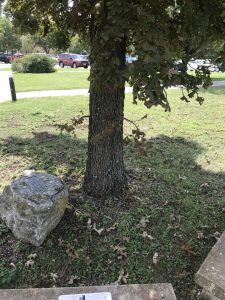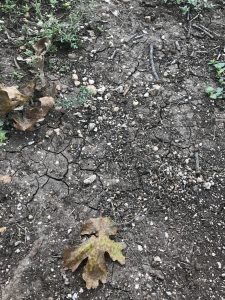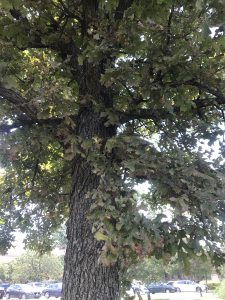 Up on the peak of a hilltop at St. Edwards University rests an old theatre with giant, cubed glass windows overlooking the skyline of downtown Austin. The outside of the theatre is a safe space to lay out on the hill, bask in the sun, or rest under a small tree that is accompanied by two cement benches and a rock. This serene spot under the tree is ideal for chatting or completing homework in solitude. After observing the rock placed in front of the tree, I knew what the real purpose of this relaxing spot on the hilltop was. The rock was topped with a plaque that states “Planted in loving memory of Blakely J. Thompson 1973-1997.” Suddenly the tree took on a bigger meaning than a lone tree overlooking Austin. This tree was a memorial, and I took interest in its history and life here at St. Edwards.
Up on the peak of a hilltop at St. Edwards University rests an old theatre with giant, cubed glass windows overlooking the skyline of downtown Austin. The outside of the theatre is a safe space to lay out on the hill, bask in the sun, or rest under a small tree that is accompanied by two cement benches and a rock. This serene spot under the tree is ideal for chatting or completing homework in solitude. After observing the rock placed in front of the tree, I knew what the real purpose of this relaxing spot on the hilltop was. The rock was topped with a plaque that states “Planted in loving memory of Blakely J. Thompson 1973-1997.” Suddenly the tree took on a bigger meaning than a lone tree overlooking Austin. This tree was a memorial, and I took interest in its history and life here at St. Edwards.
The first time visiting the tree I spent a majority of my time trying to identify its species. It’s skinny trunk is an ashy grey, only about twenty feet high with several branches extending out containing green leaves with two deep crevices on each side. After flipping through “Trees of Texas” on Texas A&M’s Forest Service website, I identified the memorial tree as a “Quercus stellata” (Texas A&M, 2017). Quercus stellata has several different names, such as Post Oak, Iron oak, and Cross oak. Post oak is typically forty to fifty feet tall and posses one of these two trunk characteristics, short and crooked or long and straight. The smaller branches and twigs are usually full of curves and twists containing “simple” green leaves that are three to five inches long with “wavy margined to deeply lobed” structure, arranged alternately on different heights on the stem. These deciduous leaves range from having three to seven lobes, the average being five. The leaves slightly vary in color and texture as you go up the tree, for example the lower leaves are more grey-brown tones while the upper leaves are dark green and illuminate a shiny reflection. Also the Post oak is monoecious, meaning it produces different flowers for males and females. The flowers cross-pollinate by wind and fertile female flowers end up becoming acorns. Additionally, this oak is tolerate to droughts and are usually in “dry to most,” rocky or sandy soils, requiring medium water use, which isn’t surprising since it is native to Texas, which can be hot and dry (U. Of Texas, 2017). Many insects are attracted to the oak because they can feed off of its wood, leaves, sap, and acorns. Several beetles, butterflies, moths, and other species have been recorded feeding on the oak tree, while squirrels and other mammals are said to munch on the acorns. Lastly, Post oak’s wood is known for its “strength, hardness, durability, and moisture resistance” and therefore is sold and used for construction lumber, railroads, fence posts and much more (Hitly 2009).
 The dry patch near Oak.
The dry patch near Oak.
St. Edward’s Post Oak fits many of these descriptions except for the size and acorn production, however I believe my tree may be too young for production. Since the tree was planted in memorial of Blakely Thompson, who passed away in 1997, I assume the tree was planted that year. On the other hand, the age of the tree when it was planted is undetermined but I assume the tree is a little over 20 years old judging on its size and the lack of acorns. Yet, as I observed its leaves change color, decrease of organism interaction, and the habitat in which it was thriving. The soil was in-fact dry and there are several spots where the rocky gravel is exposed. Nearby, a dry patch of soil ranging in about three feet in diameter was so arid that no plants grew out of the geometric shaped cracks running through it. But this was no worry to the tree, since it is accustomed to these circumstances. As September continued on, the leaves would become more brown and spotted until starting to float to the soil. The ground became even more diverse than before from mixes of twigs and leaves that falling off the oak. I also noticed a decrease in the number of butterflies in the area as time passed. Within the first two weeks I would notice about one or two fluttering around the space, but as October creeped closer I would only take note of one, If any. Nonetheless, the ants were restless throughout the entire time, climbing up and down the trunk and even climbing on me a few times. Also other crawling creatures were noted and observed to have stayed the entire time.

Overall, observing Post Oak was a relaxing and enjoyable experience since I was able to sit under the shade unbothered and watch the leaves as they shook and then fell to the soil. I highly recommend giving yourself some free time to go check out St. Edward’s Post Oak. For this tree continues to rest on the hilltop and provide shade and honor to those who stop to enjoy.
Catherine Williams
A&M, T. (n.d.). Trees of Texas. Retrieved October 09, 2017, from http://texastreeid.tamu.edu/content/TreeDetails/?id=107
Hitly, D. (n.d.). Illinois Wildflowers. Retrieved October 10, 2017, from http://www.illinoiswildflowers.info/trees/plants/post_oak.html
Texas, U. (n.d.). Plant Database. Retrieved October 10, 2017, from https://www.wildflower.org/plants/result.php?id_plant=qust
